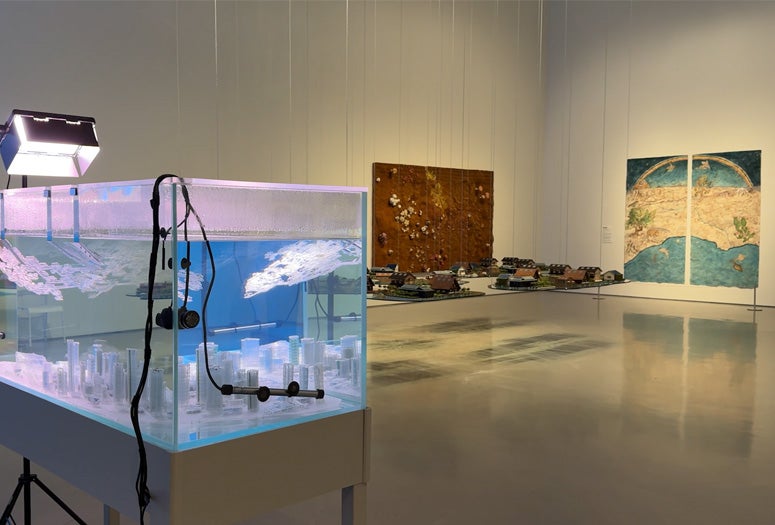
The Moody Center for the Arts at Rice University will mark Earth Month with a series of environmentally focused events that bring together artists, musicians, poets, scholars and students from across disciplines. Through these thought-provoking collaborations, the Moody will serve as a hub for creative engagement with pressing climate issues, reinforcing the intersection of art and activism that is the focus of its current exhibition “Breath(e): Toward Climate and Social Justice.”
“Hosting these events at the Moody aligns perfectly with our mission to foster interdisciplinary dialogue and creative expression,” said Alison Weaver, the Suzanne Deal Booth Executive Director of the Moody. “These collaborations showcase the power of the arts in engaging with urgent environmental topics, inspiring audiences to think critically about their role in shaping a sustainable future.”

The series kicks off March 29 with Environmental Strings, a collaboration between the Kinetic Ensemble and Rice student artists, composers and poets. Kinetic, described as “Houston’s indie, conductorless orchestra” by Houston Public Media, will premiere new works that explore climate and environmental issues.
“We will experience music, poetry and film — eight collaborative works in all — in which each piece ruminates on the issues of climate and the environment,” said Pierre Jalbert, professor of composition at the Shepherd School of Music, who emphasized the significance of a project like this for students. “It’s enriching to discuss issues of form, structure, materials, ideas and style from different perspectives in the various art forms. It can also serve as a source of inspiration with one art form influencing another.”
“The Chapel in the Hive” brings poetry and music together in an exploration of biodiversity and multispecies worlds April 5. Created by poet and scholar Joseph Campana and Shepherd School composition professor Kurt Stallmann, the performance reflects on the sacred character of nature through the perspective of honeybees, drawing from history, mythology and contemporary environmental concerns. The event will also feature a Q&A with Garnett Pruett, an artist and fourth-generation beekeeper whose “apisculptures” are featured in the “Breath(e)” exhibition.
“Visitors can expect to be immersed in a sensorium,” said Campana, the William Shakespeare Professor of English and director of the Center for Environmental Studies (CES) and EcoStudio. “That’s literally true inasmuch as they will be surrounded by speakers to create a dynamic sound environment. But they’ll also be immersed in story, ritual and history as we draw on the sounds of bees, the history of how humans have been fascinated by bees and stories that ask us to think about the desire to save — or be saved by — nature.”
Campana highlighted the importance of interdisciplinary collaboration at Rice.

“The world around us is too complex for any one discipline or expertise,” Campana said. “Conversation sustains us and gives us the only chance of working together to grapple with increasingly difficult planetary circumstances. More than that, we’re inspired by the power the arts have to immerse us in worlds familiar and unfamiliar at the same time, to incite the imagination, to create connections where we didn’t think they existed and to provoke difficult conversations about being in the world with so many other forms of life.”
On April 11-12, the Moody will host “SPILL,” a documentary play directed by Weston Twardowski that examines the impact of the Deepwater Horizon explosion 15 years after the disaster. Written by award-winning playwright Leigh Fondakowski, “SPILL” is based on interviews with Gulf Coast residents and explores the personal and environmental consequences of the tragedy.
“Theater demands interdisciplinary work: A play involves acting and directing but also lighting, set design, costuming and music,” said Twardowski, associate director of CES and EcoStudio. “The kind of immersive storytelling we aspire to requires collaboration with a wide range of artists. With a show like ‘SPILL,’ I’m thrilled to show audiences how theater can merge not just different art forms but also science, technology, history and ethnography to create an artwork that both entertains and hopefully inspires meaningful conversation about the place we live in and the world around us.”
Earth Month inspired-programming concludes April 19 with New Art / New Music, an annual collaboration between the Shepherd School and the Moody. This year’s program features original student compositions responding to “Breath(e)” and showcasing the interplay between visual art and music.
“New Art / New Music is always such an exciting concert because it’s all about creative dialogue — this year, six composers from Shepherd are bringing everything from string ensembles to electric guitar, all in response to the exhibit’s message around climate justice,” said senior Jaylin Vinson, a composition student and event organizer along with graduate student Victor Cui. “I love collaborations like this because they really highlight the power of the arts in conversation. Music and visual art bring out different layers of meaning in each other, and when they’re in dialogue, they create something entirely new.”
Learn more about each of these events here.


